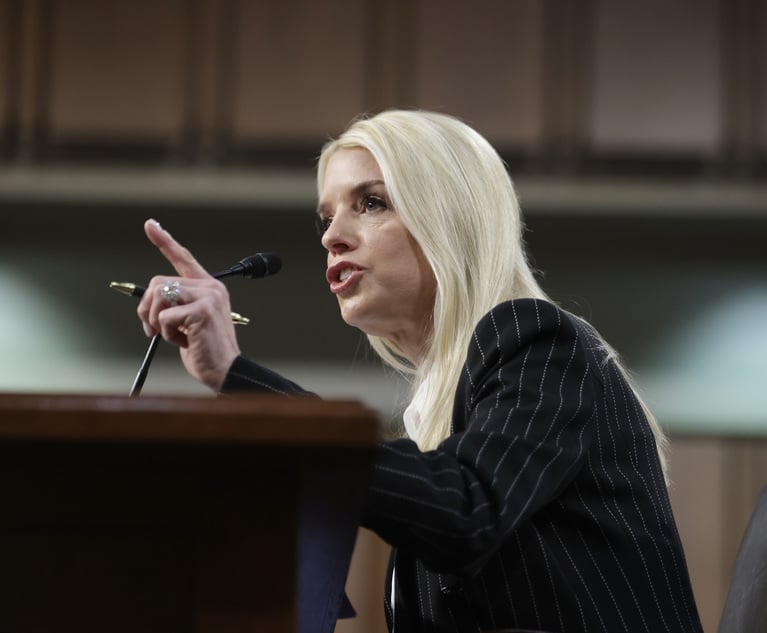'Tis the Season for Overtime Regulations for Both the DOL and L&I
The DOL estimates that its final rule, which will become effective Jan. 1, 2020, will extend overtime pay eligibility to 1.3 million workers. The salary threshold in the final rule is nearly identical to the $679 per week proposed earlier this year by the DOL.
October 28, 2019 at 01:09 PM
8 minute read
By Andrea M. Kirshenbaum
 Andrea Kirshenbaum
Andrea Kirshenbaum
It's beginning to feel a lot like … Groundhog Day in the wage-and-hour world. On Sept. 24, the U.S. Department of Labor (DOL) issued its final overtime rule (DOL's final rule) that raises the minimum salary threshold for executive, administrative, and professional, employees from $455 per week ($23,660 per year) to $684 per week ($35,568 per year) to qualify as exempt from overtime pay under the Fair Labor Standards Act (FLSA). The DOL estimates that its final rule, which will become effective Jan. 1, 2020, will extend overtime pay eligibility to 1.3 million workers. The salary threshold in the final rule is nearly identical to the $679 per week proposed earlier this year by the DOL.
Meanwhile, the Pennsylvania Department of Labor & Industry (L&I), which in June 2018 had issued proposed rulemaking to update the executive, administrative, and professional, (EAP) exemptions to the Pennsylvania Minimum Wage Act (PMWA), announced Oct. 17 that it submitted its final regulation (L&I's final rule) to Pennsylvania's Independent Regulatory Review Commission and legislative oversight committees. L&I's final rule begins with the new federal level of $684 per week ($35,568 per year), but it does not end there. In its press release, L&I stated that, "the Wolf administration does not believe the new U.S. DOL rule truly reflects what Pennsylvanians are being paid." L&I's final rule provides for a phased-in increase of the salary level to $684 per week ($35,568 per year) as of Jan. 1, 2020, then to $780 per week ($40,560 per year) in 2121 and to $875 per week ($45,550 per year) in 2022. Following these increases, beginning in 2023 the salary level will be automatically adjusted every three years "at a rate equal to the 10th percentile of Pennsylvania workers who work in exempt executive, administrative or professional classifications." L&I estimates that following implementation of its final rule, an additional 82,000 Pennsylvania employees will be eligible for overtime by 2022.
L&I's final rule is set to go before Pennsylvania's five-member Independent Regulatory Review Commission (IRRC) on Nov. 21. The IRRC is tasked with considering, among other things, whether L&I is acting within its statutory authority, whether the final rule is consistent with the PMWA, what the economic impact of the final rule would be on the regulated entities and whether the final rule is reasonable. Of note, following L&I's issuance of its proposed rulemaking in 2018, the IRRC expressed concern that L&I had not justified the proposed regulations and that the PMWA salary level would not be aligned with its federal counterpart. Following these comments, L&I embarked on a "listening campaign" and has lowered the final salary level from the level included in its proposed regulations of $921 per week ($47,892 per year) to $875 per week ($45,550 per year).
Under current DOL and L&I regulations, an employee can qualify as an exempt executive, administrative or professional employee if:
- The employee is paid on a salary basis (the salary basis test);
- The employee's salary meets a minimum specified salary amount (the salary level test); and
- The employee's duties meet the criteria set forth in the regulations (the duties test).
Both the DOL and L&I's final rule address the salary level test and do not alter the salary basis test. While the DOL made no changes to its duties test, L&I revised some of the duties language to bring that language closer to DOL regulations.
Likewise, the DOL and L&I final rules both allow for up to 10 percent of an exempt EAP employee's salary to come from nondiscretionary bonuses and incentive payments so long as those forms of compensation are paid, at a minimum, on an annual basis.
The DOL's final rule increases the annual compensation threshold from $100,000 to $107,432 for employees to qualify for the highly compensated employee exemption (which is far less than what was proposed by the DOL earlier this year). Of note, the PMWA does not contain a highly compensated exemption.
While Pennsylvania has endorsed "automatic" updating of its regulations every three years, notably absent from the DOL final rule is any requirement that the regulations be updated on a specific schedule. Rather, the DOL indicated in one of the guidance documents issued with the final rule that "the department believes such a commitment could deprive the department of flexibility to adapt to unanticipated circumstances, and believes that prevailing economic conditions, rather than fixed timelines, should drive future updates."
As employers well remember, in 2016 the Obama administration's DOL announced a final rule (2016 rule), which set the minimum salary level at $913 per week ($47,476 per year) and required automatic triennial increases to the minimum salary threshold. Dozens of states and business groups requested a nationwide injunction blocking the 2016 rule from taking effect, which was granted. After the change in administrations and while the case was on appeal, the DOL asked the U.S. Court of Appeals for the Fifth Circuit to hold the case in abeyance while the DOL issued a new proposed rule.
When the 2016 rule was announced by the Obama administration, some employers chose to increase employee salaries in an effort to maintain their exempt status. For those employers, both the DOL and L&I final rule will not alter their employees' exempt status under the FLSA or the PMWA. Employers who did not make changes to comply with the 2016 rule (or who initially made changes and then pulled them back after the 2016 rule was enjoined) must again consider whether to increase employee salaries or re-classify employees who earn below the new threshold and meet the other criteria to qualify for exempt status.
What's Next
In Pennsylvania, employers should stay tuned to see whether L&I's final rule will pass muster with the IRRC. Of note, it has been reported that Gene Barr, president and CEO of the Pennsylvania Chamber of Business and Industry is urging the IRRC to reject L&I's final rule. On the federal level, absent an injunction by a court, the DOL's final rule is set to go into effect on Jan. 1, 2020.
Implementation of the DOL Final Rule and Tips for Employers
- For EAP employees currently classified as exempt and earning close to the new federal salary threshold, employers may choose to increase the salary level to maintain exempt status (especially where the employee works substantially more than 40 hours per week).
- In contrast, previously exempt employees who will be making less than the new salary level of $684 per week ($35,568 per year) as of Jan. 1, 2020, will need to be reclassified as nonexempt. For those employees, employers will need to assess how much (if any) overtime the newly reclassified employees likely will work and determine an hourly wage rate or salary for those employees taking into account those estimates.
- Employers should consider the impact of the DOL's final rule generally, assessing its impact not only on individual employees and departments but more broadly looking at its effect on workflow and business operations.
- For organizations that have a significant number of exempt employees currently earning less than $684 per week, compliance with the final rule will potentially have ripple effects throughout the organization, impacting the work of both exempt and nonexempt employees.
- Given the Jan. 1, 2020, effective date of the DOL's final rule, employers should analyze the associated impact on their businesses and begin the process of making any needed modifications immediately.
- Employers in Pennsylvania should continue to monitor the status of L&I's final rule with the knowledge that additional increases to the salary level may well be on the horizon.
- Multi-state employers should be aware that Pennsylvania is not the only state that is trying to follow in the footsteps of California and New York, which for several years have maintained a higher salary level requirement. There are efforts afoot to increase the salary level in Maine, Massachusetts, Colorado, Washington and most recently Michigan. Employers in these (and other) jurisdictions should stay tuned as the wage-and-hour landscape remains in a state of constant change.
Andrea M. Kirshenbaum is the chair of Post & Schell's wage and hour practice group, a principal in its employment and employee relations and labor practice groups, and a member of the firm's appellate department. Contact her at [email protected].
This content has been archived. It is available through our partners, LexisNexis® and Bloomberg Law.
To view this content, please continue to their sites.
Not a Lexis Subscriber?
Subscribe Now
Not a Bloomberg Law Subscriber?
Subscribe Now
NOT FOR REPRINT
© 2025 ALM Global, LLC, All Rights Reserved. Request academic re-use from www.copyright.com. All other uses, submit a request to [email protected]. For more information visit Asset & Logo Licensing.
You Might Like
View All
Lawyers' Phones Are Ringing: What Should Employers Do If ICE Raids Their Business?
6 minute read


3rd Circuit Strikes Down NLRB’s Monetary Remedies for Fired Starbucks Workers
Trending Stories
- 1Who Is Nicholas J. Ganjei? His Rise to Top Lawyer
- 2Delaware Supreme Court Names Civil Litigator to Serve as New Chief Disciplinary Counsel
- 3Inside Track: Why Relentless Self-Promoters Need Not Apply for GC Posts
- 4Fresh lawsuit hits Oregon city at the heart of Supreme Court ruling on homeless encampments
- 5Ex-Kline & Specter Associate Drops Lawsuit Against the Firm
Who Got The Work
J. Brugh Lower of Gibbons has entered an appearance for industrial equipment supplier Devco Corporation in a pending trademark infringement lawsuit. The suit, accusing the defendant of selling knock-off Graco products, was filed Dec. 18 in New Jersey District Court by Rivkin Radler on behalf of Graco Inc. and Graco Minnesota. The case, assigned to U.S. District Judge Zahid N. Quraishi, is 3:24-cv-11294, Graco Inc. et al v. Devco Corporation.
Who Got The Work
Rebecca Maller-Stein and Kent A. Yalowitz of Arnold & Porter Kaye Scholer have entered their appearances for Hanaco Venture Capital and its executives, Lior Prosor and David Frankel, in a pending securities lawsuit. The action, filed on Dec. 24 in New York Southern District Court by Zell, Aron & Co. on behalf of Goldeneye Advisors, accuses the defendants of negligently and fraudulently managing the plaintiff's $1 million investment. The case, assigned to U.S. District Judge Vernon S. Broderick, is 1:24-cv-09918, Goldeneye Advisors, LLC v. Hanaco Venture Capital, Ltd. et al.
Who Got The Work
Attorneys from A&O Shearman has stepped in as defense counsel for Toronto-Dominion Bank and other defendants in a pending securities class action. The suit, filed Dec. 11 in New York Southern District Court by Bleichmar Fonti & Auld, accuses the defendants of concealing the bank's 'pervasive' deficiencies in regards to its compliance with the Bank Secrecy Act and the quality of its anti-money laundering controls. The case, assigned to U.S. District Judge Arun Subramanian, is 1:24-cv-09445, Gonzalez v. The Toronto-Dominion Bank et al.
Who Got The Work
Crown Castle International, a Pennsylvania company providing shared communications infrastructure, has turned to Luke D. Wolf of Gordon Rees Scully Mansukhani to fend off a pending breach-of-contract lawsuit. The court action, filed Nov. 25 in Michigan Eastern District Court by Hooper Hathaway PC on behalf of The Town Residences LLC, accuses Crown Castle of failing to transfer approximately $30,000 in utility payments from T-Mobile in breach of a roof-top lease and assignment agreement. The case, assigned to U.S. District Judge Susan K. Declercq, is 2:24-cv-13131, The Town Residences LLC v. T-Mobile US, Inc. et al.
Who Got The Work
Wilfred P. Coronato and Daniel M. Schwartz of McCarter & English have stepped in as defense counsel to Electrolux Home Products Inc. in a pending product liability lawsuit. The court action, filed Nov. 26 in New York Eastern District Court by Poulos Lopiccolo PC and Nagel Rice LLP on behalf of David Stern, alleges that the defendant's refrigerators’ drawers and shelving repeatedly break and fall apart within months after purchase. The case, assigned to U.S. District Judge Joan M. Azrack, is 2:24-cv-08204, Stern v. Electrolux Home Products, Inc.
Featured Firms
Law Offices of Gary Martin Hays & Associates, P.C.
(470) 294-1674
Law Offices of Mark E. Salomone
(857) 444-6468
Smith & Hassler
(713) 739-1250





